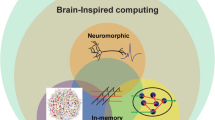Abstract
In the final essay of this series the gaps between biology and engineering are examined, and methods are suggested for crossing them. Creativity is seen as the essential, and TRIZ (the Russian Theory of Inventive Problem Solving) is recommended as the best set of methods both for stimulating creativity and for solving technical problems. When the catalogue of Inventive Principles of TRIZ is used to bring biology and technology to the same level of detail, the comparison shows that the similarity is only about 12%. The differences largely reside in the reliance of energy as a controlling parameter in conventional technology and the replacement of energy by information in biological systems. Although we might be moving slowly in this direction, a numerically based comparison such as this should provide more impetus.
Similar content being viewed by others
References
Mossman S T I. Parkesine and celluloid. Special Publication — Royal Society of Chemistry, 1994, 141, 10–25.
Donald A M, Windle A H. Liquid Crystalline Polymers. The University Press, Cambridge, 1992.
Watts A W. The Way of Zen. Penguin Books, Harmondsworth, 1962.
Vincent J F V. Applications — Influence of biology on engineering. Journal of Bionic Engineering, 2006, 3, 161–177.
Holgate A. The Art in Structural Design. An Introduction and Sourcebook. The University Press, Oxford, 1986.
Ribot T. Essays on the Creative Imagination. Routledge & Kegan Paul, London, 1906.
Gruber H E, Davis S N. Inching our way up Mount Olympus: The evolving-systems approach to creative thinking. In: The Nature of Creativity (ed Sternberg R J). Cambridge University Press, New York, 1991, 243–270.
Schank R C. Creativity as a mechanical process. In: The Nature of Creativity (ed Sternberg R J). Cambridge University Press, New York, 1991, 220–238.
Altshuller G, Shulyak L. 40 Principles — TRIZ Keys to Technical Innovation. Technical Innovation Center, Inc, Worcester, Massachusetts, USA, 1998.
Heinrich B. The Hot-blooded Insects: Strategies and Mechanisms of Thermoregulation. Springer, Berlin & London, 1993.
Fuji R, Novales R R. Cellular aspects of the control of physiological colour changes in fishes. American Zoologist, 1969, 9, 453–463.
Niklas K J, Paolillo D J. The role of the epidermis as a stiffening agent in Tulipa (Liliaceae) stems. American Journal of Botany, 1997, 84, 735–744.
Karam G N, Gibson L J. Biomimicking of animal quills and plant stems: cylindrical shells with foam cores. Materials Science and Engineering C, 1994, 2, 113–132.
Vincent J F V, Owers P. Mechanical design of hedgehog spines and porcupine quills. Journal of Zoology, 1986, 210, 55–75.
Gibson L J, Ashby M F. Cellular Solids, Structure and Properties. The University Press, Cambridge, 1997.
Messenger J B. Consequences of colour-blindness for cuttlefish camouflage. Journal of Physiology, 1997, 504, 23.
Knight D P, Vollrath F. Liquid crystals and flow elongation in a spider’s silk production line. Proceedings of the Royal Society B, 1999, 266, 519–523.
Knight D P, Feng D. Formation of the dogfish egg capsule, a coextruded, multilayer laminate. Biomimetics, 1992, 1, 151–176.
Dawson C, Vincent J F V, Rocca A-M. How scales open in female pine cones. Nature, 1997, 390, 668.
Jeronimidis G. Wood, one of nature’s challenging composites. In: The Mechanical Properties of Biological Materials, Symposia of the Society for Experimental Biology 34(eds. Vincent J F V, Currey J D), Cambridge University Press, UK, 1980, 169–182.
Li S H, Zeng Q Y, Xiao Y L, Fu S Y, Zhou B L. Biomimicry of bamboo bast fiber with engineering composite materials. Materials Science and Engineering C: Biomimetics Materials Sensors and Systems, 1995, 3, 125–130.
Neville A C. Biology of Fibrous Composites; Development Beyond the Cell Membrane. The University Press, Cambridge, 1993.
Altshuller G. The Innovation Algorithm, TRIZ, Systematic Innovation and Technical Creativity. Technical Innovation Center Inc, Worcester, Massachusetts, USA, 1999.
Schmitz H, Bleckmann H. The photomechanic infrared receptor for the detection of forest fires in the beetle Melanophila acuminata (Coleoptera: Buprestidae). Journal of Comparative Physiology A: Sensory, Neural and Behavioural Physiology, 1998, 182, 647–657.
Bialek W. Physical limits to sensation and perception. Annual Review of Biophysics and Biophysical Chemistry, 1987, 16, 455–478.
Vincent J F V, Bogatyreva O A, Bogatyrev N R, Bowyer A, Pahl A-K. Biomimetics—its practice and theory. Journal of the Royal Society Interface, 2006, 3, 471–482.
Vincent J F V. The nature of materials. Journal of Bionics Engineering, 2005, 2, 93–114.
Ashby M F, Brechet Y J M. Designing hybrid materials. Acta Materialia, 2003, 51, 5801–5821.
Author information
Authors and Affiliations
Corresponding author
Rights and permissions
About this article
Cite this article
Vincent, J.F.V. The materials revolution. J Bionic Eng 3, 217–234 (2006). https://doi.org/10.1016/S1672-6529(07)60005-5
Published:
Issue Date:
DOI: https://doi.org/10.1016/S1672-6529(07)60005-5




